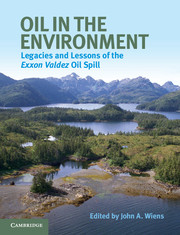Book contents
- Frontmatter
- Contents
- List of contributors
- Use of acronyms
- Acknowledgments
- A bibliographic note
- Prologue
- Part I Introduction and background
- Part II Oil in the environment
- Part III Biological effects
- 9 Cytochrome P450 1A (CYP1A) as a biomarker in oil spill assessments
- 10 Assessing effects and recovery from environmental accidents
- 11 Shoreline biota
- 12 Oiling effects on pink salmon
- 13 Pacific herring
- 14 Oil and marine birds in a variable environment
- 15 Sea otters: trying to see the forest for the trees since the Exxon Valdez
- Part IV Assessing oil spill effects and ecological recovery
- Part V Conclusions
- Index
- References
13 - Pacific herring
Published online by Cambridge University Press: 05 July 2013
- Frontmatter
- Contents
- List of contributors
- Use of acronyms
- Acknowledgments
- A bibliographic note
- Prologue
- Part I Introduction and background
- Part II Oil in the environment
- Part III Biological effects
- 9 Cytochrome P450 1A (CYP1A) as a biomarker in oil spill assessments
- 10 Assessing effects and recovery from environmental accidents
- 11 Shoreline biota
- 12 Oiling effects on pink salmon
- 13 Pacific herring
- 14 Oil and marine birds in a variable environment
- 15 Sea otters: trying to see the forest for the trees since the Exxon Valdez
- Part IV Assessing oil spill effects and ecological recovery
- Part V Conclusions
- Index
- References
Summary
Introduction
Following the Exxon Valdez oil spill in 1989, concern quickly arose about potential effects on Pacific herring (Clupea pallasii). As the most abundant forage fish in Prince William Sound (PWS), Pacific herring is a keystone species, consuming zooplankton and providing high-quality prey for birds, marine mammals, and other fish (Spies, 2007). Pacific herring are also commercially important, supporting five fisheries in PWS: two spring fisheries for roe (eggs as food), two spring fisheries for eggs on kelp (a delicacy), and a fall “fish” fishery for bait and food. The four spring fisheries are the first opportunity to conduct commercial fishing after the winter. These five fisheries provided landings (i.e., landed catches) worth about $12 million in the year before the spill (Brady et al., 1991a). And Pacific herring are an important subsistence food for people living in the area.
Herring life history is complex (Fig. 13.1; Blaxter, 1985; Hay, 1985; McQuinn, 1997), and multiple factors – such as ocean conditions, prey availability, predation, and competition – structure herring population dynamics in PWS and the Gulf of Alaska (GOA). Establishing whether and how the spill affected herring required separating spill-related injuries from changes caused by the complex of other factors affecting herring. Moreover, little information about several aspects of herring life history and population dynamics in PWS was available at the time of the spill. Thus, although the overall goal of scientific investigations of herring was to assess the effects of the oil spill, it was also necessary to undertake basic research to fill in the information gaps necessary to assess the spill’s effects.
- Type
- Chapter
- Information
- Oil in the EnvironmentLegacies and Lessons of the Exxon Valdez Oil Spill, pp. 292 - 317Publisher: Cambridge University PressPrint publication year: 2013
References
- 1
- Cited by

